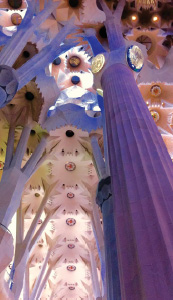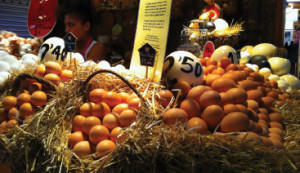BARCELONA LIKE A LOCAL
THE ICOI WORLD CONGRESS OFFERS THE PERFECT OPPORTUNITY TO TAKE IN THE WONDERS OF CATALAN. BY LEA LANE
BARCELONA, THE HISTORIC Catalan city in eastern Spain, hosts the ICOI World Congress at the end of March and beginning of April. Although there’s of course plenty of dentistry to take in at the show, there’s still more to see before and after.
You’ll probably focus downtime on the must-sees. To truly maximize your experience, though, you’ll want to tack on some insider twists as unique as this elegant city itself, an Old World beauty that adds a dollop of surprise to just about everything, from its dual heritage to its zany architecture and offbeat language.
 Let’s start with an icon. Designed by Antonin Gaudí in 1892 and projected to be un-der construction until 2030, Sagrada Familia is the immense cathedral, known through-out the world for its Modernist sand-castle exterior, that looks like no other building on earth. To skip the lines, book an hour-long architectural tour. In any case, Sagrada Familia’s interior is as grand as its exterior, and worth the wait: It’s a unique expression of stone, ceramics, forged iron and glass.
Let’s start with an icon. Designed by Antonin Gaudí in 1892 and projected to be un-der construction until 2030, Sagrada Familia is the immense cathedral, known through-out the world for its Modernist sand-castle exterior, that looks like no other building on earth. To skip the lines, book an hour-long architectural tour. In any case, Sagrada Familia’s interior is as grand as its exterior, and worth the wait: It’s a unique expression of stone, ceramics, forged iron and glass.
Warning: You may come out with a sore neck from savoring the never-be-fore-imagined details that climb the walls up to the vaulted ceilings. Sore legs, too, if you ascend the cathedral towers to get a super-lative view of Barcelona.
You can ease your muscles, eat and view the Sagrada Familia façade at leisure at a neighborhood outdoor cafe. Or try nearby La Paradeta Sagrada Familia (Passatage de Simo) for fresh seafood. Barcelona is known for tapas, small plates that have become a staple of restaurants throughout the world, and you can choose between a light repast of a few plates and a big-deal meal of many.
Park Güell, the meandering Unesco Her-itage site on the outskirts of the city center, is another Gaudí masterpiece. The quirky colonnaded hall and Gaudí’s house are just two of the surreal delights. Leave time to enjoy the combination of nature and original architecture — and for a quick lunch, buy cheese, sausage and other light fare at infor-mal venues scattered around the park.
You can relax and people-watch on the famed serpentine mosaic bench that wraps around the top of the park. The seat is un-usually comfortable because, ever the vision-ary, Gaudí had a workman sit in soft plaster to record the correct anatomical curve (just like a dental impression!), beating the science of ergonomics by half a century.
Two Gaudí-designed residential build-ings make for a perfect city walk: the famed Casa Mila, known as La Pedrera, and Casa Batlló, which you can tour. But don’t overlook other Gaudí buildings, including Casa Vicens, Palau Güell, Finca Güell and Casa Calvet. Most hotels offer maps that highlight these one-of-a-kind Modernist beauties. Just want to see the exteriors? Grab a cab or Uber and create your own Gaudí exploration around the city.
Gaudí is not the only Barcelona archi-tect with a Unesco World Heritage building to his credit. One of the (often overlooked) greatest examples of Art Nouveau archi-tecture anywhere is the Palau de la Música Catalana. Known for its ornate façade and opulent auditorium with stained-glass ceiling, this palace of music, inaugurated in 1908, was designed by Catalan architect Lluís Domènech i Montaner. It features musical performances throughout the year amid its exquisite surroundings.
To get inside without attending a con-cert, you can opt for a guided tour, but even a lunch or snack in the vintage cafe on-site will give you an idea of the beauty that lies within. For heartier fare, across the street is the Alsur Café (Sant Pere Mes Alt 4), with a relaxing lounge and loads of tapas.
The city’s narrow streets retain a Medieval feel, but Las Ramblas is the center of Barce-lona: a blocks-long pedestrian walkway where locals and tourists stroll, talk, flirt, shop, rest and eat. Also milling around here are pickpockets. (Nothing’s perfect.) Stay alert.
A fine place to sample Catalan food is the abundant and colorful La Boqueria Market on Las Ramblas. Grab a stool at any of the stalls — you’ll likely be next to a friendly local — point to what you want and dig into the abundance: octopus, olives, peppers. Hop around — a plate here, a plate there. The food and experience are as au-thentic as you can find here.
Pablo Picasso was born in Barcelona and lived and studied here; at the Museo Picasso you can peruse his early work. Most fascinating are the 12-year-old Pablo’s copies of great master paintings, many that look as authentic as the originals.
Next door at El Xampanyet (Carrer de Montcade, 22), you can talk about the art or just elbow your way to the bar for a glass of sparkling Cava and plates of jambon cut from the bone, grilled artichoke hearts, tomato bread, boiled potatoes, mini-pepperonis and dozens of other tasty nibbles.
 The city itself, with its 1992 Olympic village, artsy neighborhoods and harbor area, offers more than enough to keep you en-thralled throughout the ICOI conference, but try to leave a day or two free to play outside. Beach and mountain getaways are within an easy drive up the mountains or a train ride along the sunny Mediterranean coast.
The city itself, with its 1992 Olympic village, artsy neighborhoods and harbor area, offers more than enough to keep you en-thralled throughout the ICOI conference, but try to leave a day or two free to play outside. Beach and mountain getaways are within an easy drive up the mountains or a train ride along the sunny Mediterranean coast.
Sitges is a popular resort about half an hour from Barcelona, with loads of beachy seafood restaurants. You can relax by the water and end the day at Queenz Dinner Show (Carrer Del Bonaire, 17), which has a good restaurant and adult cabaret entertainment.
Nearby Vilanova i la Geltrú, a fishing town, has fewer tourists, a Medieval quarter and excellent eateries at reasonable prices. For good local food, Infinit Restaurant (Lliber-tat 107–109) serves fish and steak in a post-industrial warehouse; try the chef’s menu.
Montserrat is about an hour’s drive up the mountains from Barcelona, during which you’ll take in some of Europe’s most dramatic scenery. The Benedictine abbey Santa Maria de Montserrat is set within a mountain and enshrines the venerated image of the Virgin of Montserrat. Even if you don’t want to spend time in line to see it, the other artworks are well worth the trip.
Or you could in-stead take a hike in the clouds and then treat yourself to a traditional coca d’ou, a sweet egg pastry, in a terraced park overlooking the city below.
One tip that’s guaranteed to bring you extra smiles: Barcelona might be located in Spain, but the popular language remains Catalan, and if you learn even a few useful phrases you’ll be sure to please the locals. For starters, commit these to memory: Bon dia (hello); a reveure (good-bye); merces (thank you); and sisplau (please).
Be sure, too, to learn one useful word that, like the city’s perfect veneer, describes just about everything in Barcelona: the archi-tecture, climate, music, mountains, beaches, cuisine, art and people: That word is bonic, and it means beautiful.
Travel writer and journalist LEA LANE last wrote for Incisal Edge about lengthy journeys along Europe’s rivers.



